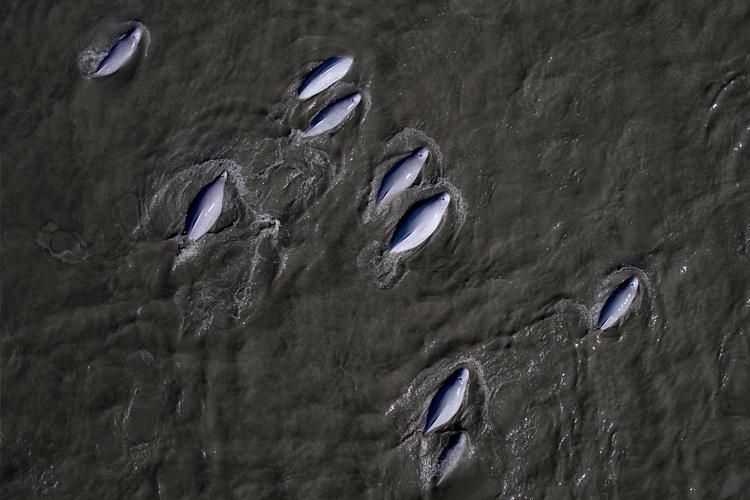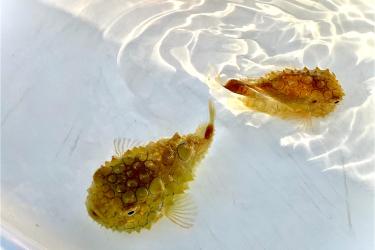The Cook Inlet beluga whale is one of eight featured species of marine wildlife most at-risk of extinction. In 2008, this distinct population of belugas was added to the U.S. Endangered Species Act's list of endangered and threatened wildlife as an "endangered" species. The reason for listing was because the population had failed to recover from a period of unregulated Alaska Native subsistence hunting, and had continued to decline despite putting hunting regulations into place.
Once thought to number about 1,300 whales in the late 1970s, the last population estimate was 340 whales in 2014. Aerial surveys to estimate population numbers and to monitor distribution for Cook Inlet belugas have been conducted by the Alaska Fisheries Science Center's Marine Mammal Laboratory since 1993. The abundance survey typically takes place in early June when whales gather at river mouths to feed on salmon and eulachon (a small, schooling fish) that are returning from the ocean to spawn in natal streams.
Our team of four scientists assumes the roles of marine mammal observers, computer data recorder, and videographer to collect these data.
Meet the Bloggers
Kim Shelden is a Marine Biologist in the Cetacean Assessment and Ecology Program at the Alaska Fisheries Science Center's Marine Mammal Laboratory. Kim has been a part of the Cook Inlet beluga aerial survey project since it began in 1993.
Starting as a videographer, observer, and data recorder, she took over as Chief Scientist in August 2007. Kim has logged over 740 hours flying surveys over Cook Inlet.
Julie Mocklin is a NOAA Fisheries affiliate through the Joint Institute for the Study of the Atmosphere and Ocean at the University of Washington. Julie began her career as a whale watch naturalist and quickly moved on to conducting right whale and harbor porpoise aerial surveys in the Gulf of Maine.
Julie began working for the Marine Mammal Lab as a volunteer in 2002 and became part of the bowhead group in 2005. In the interim, she flew harbor porpoise surveys in Southeast Alaska and was the boat driver for a study on energetics and behavior of southern resident killer whales for the Northwest Fisheries Science Center, NOAA Fisheries.
Julie's career has focused on aerial surveys and obtaining photographs of cetaceans for abundance estimates and life history data. She got her Masters of Science at the University of Washington, using aerial photos to learn about bowhead whale feeding behavior.
Julie has worked as observer and videographer for the Cook Inlet beluga aerial surveys intermittently since 2007.
Linda Vate Brattstrom is a NOAA Fisheries affiliate through the Joint Institute for the Study of the Atmosphere and Ocean at the University of Washington.
Linda started at Alaska Fisheries Science Center in 2007 doing beluga video analysis. Since then she's been working on both beluga and bowhead whale projects.
One of her favorite aspects of her job is to take part in the Cook Inlet beluga surveys.
Christy Sims is a NOAA Fisheries affiliate through the Joint Institute for the Study of the Atmosphere and Ocean at the University of Washington (UW).
Christy started as a photo-identification volunteer at the Alaska Fisheries Science Center in 1998, and has been working with the Cook Inlet beluga whale project since completing her Masters of Marine Affairs at the UW in 2001. She has worked as observer and videographer on the Cook Inlet beluga aerial surveys since 2003.
When she isn't analyzing video or designing and managing databases, Christy enjoys bringing her co-workers her experimental bake-off recipes, hanging out with family and friends, playing outdoors, reading and travelling.






